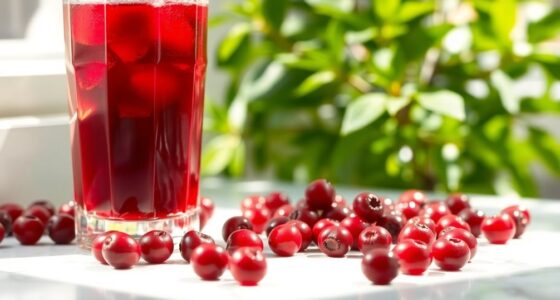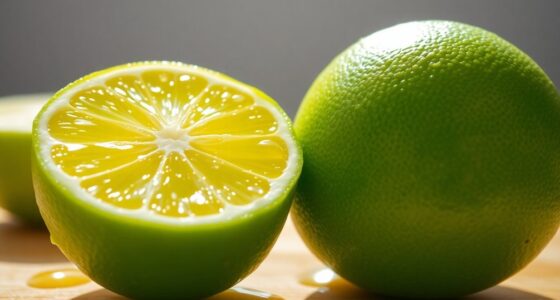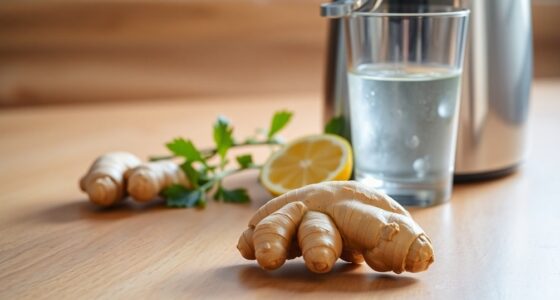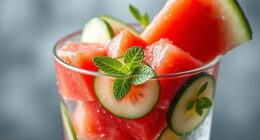To break a juice fast, start by reintroducing easy-to-digest foods like bananas or warm soups. Focus on small, frequent meals and stay hydrated with water or herbal teas. Gradually incorporate fresh juices alongside solid foods to maintain nutrient intake. Afterward, add protein sources such as plant-based powders to help with recovery and satiety. Avoid processed foods and added sugars for a healthier transition. If you want more tips on this process, keep exploring!
Key Takeaways
- Gradually reintroduce easy-to-digest foods, starting with fruits like bananas and watermelon or warm soups like pumpkin or squash.
- Stay well-hydrated by drinking plenty of water and herbal teas to support digestion during the transition.
- Include fresh juices alongside solid meals to maintain nutrient levels and support overall health.
- Incorporate easily digestible protein sources, such as lactose-free shakes or plant-based powders, to aid muscle recovery.
- Avoid processed foods and added sugars to promote healthy eating habits and establish a balanced diet post-cleanse.

Breaking a juice fast can be a delicate process, so it's important to approach it with care. After days of consuming only liquids, your digestive system needs time to adjust before you start eating solid foods again. To ease the transition, you'll want to gradually reintroduce easy-to-digest foods. Think about starting with options like bananas, watermelon, or warm soups made from pumpkin or squash. These foods are gentle on your stomach and can help prevent any digestive discomfort that might arise from diving headfirst into a heavy meal.
As you begin to incorporate solid foods into your diet, focus on consuming small meals throughout the day. This strategy not only helps ease your transition but also allows you to monitor your body's reactions closely. If you experience nausea or tummy aches, you'll have a better chance of identifying what mightn't be sitting well with you. Pay attention to how your body responds, and adjust your food choices accordingly. It's all about finding that balance and ensuring your body feels good.
Don't forget about hydration during this period. Drinking plenty of water or herbal teas can support digestion and help your body adjust to the reintroduction of solid foods. Staying hydrated is essential, especially after a juice cleanse, as it aids in flushing out any toxins and keeps your digestive system functioning optimally.
Plus, incorporating fresh juices alongside your meals ensures you continue to receive essential nutrients. Fresh juices can complement your solid food intake and maintain the nutrient levels you enjoyed during your juice fast.
Another crucial aspect to consider is protein. Since you likely missed out on adequate protein during your juice fast, it's important to incorporate good protein sources as you start eating solid foods again. Consider lactose-free protein shakes or plant-based powders, which are easy to digest and can support muscle recovery and satiety. Including these in your meals can help you feel more satisfied and balanced as you adjust back to regular eating patterns.
Remember to avoid processed foods and added sugars during this transition. They can disrupt your digestive system and undermine the healthy eating habits you’re aiming to establish after your juice cleanse. Stick to whole, nourishing foods that promote well-being and energy. Incorporating foods like fresh fruits, vegetables, and lean proteins will help you regain strength and maintain the benefits gained from your cleanse. Additionally, stay hydrated by drinking plenty of water and herbal teas to support your detoxification process. If you’re considering adding prune juice to your diet for its digestive benefits, you might be wondering, “how long does prune juice last? ” Ensure you check the expiration date and store it properly to enjoy its full benefits.
Frequently Asked Questions
What Should You Eat After a Juice Fast?
After a juice fast, you should start by eating easy-to-digest foods like bananas, melons, and leafy greens.
On the second day, add small portions of whole grains like quinoa or brown rice to aid digestion.
By the third day, introduce soft proteins such as yogurt, eggs, or lean chicken.
Remember to stay hydrated with water and fresh juices, and avoid high-fat, sugary, or processed foods to ease the transition back to solid meals.
What Is the Best Way to Break a Juice Fast?
Breaking a juice fast can feel like stepping into a culinary wonderland!
Start by reintroducing solid foods gradually; think soft fruits and vegetable soups on day one.
Space out small meals to help your digestive system adjust.
Don't forget to add protein sources like lactose-free shakes or plant-based powders for muscle maintenance.
Keep enjoying fresh juices for nutrients, and listen to your body—adjust your food pace based on how you're feeling.
How to Come off of a Liquid Fast?
To come off a liquid fast, start by reintroducing solid foods gradually.
Begin with easily digestible options like fruits and light soups. Instead of large meals, focus on 5-6 small portions throughout the day to ease your stomach back into solid foods.
Incorporate protein sources, like smoothies, to support recovery. Stay hydrated with water or herbal teas, and pay attention to how your body reacts, adjusting accordingly for comfort.
What Is the Hardest Day of a Juice Cleanse?
Day 2 of a juice cleanse can feel like climbing a steep mountain; you're facing cravings and fatigue that challenge your resolve.
You might experience headaches and emotional ups and downs as the novelty fades, pushing you to confront your habits. Staying hydrated and mixing up your juices can ease the discomfort.
Conclusion
Breaking a juice fast isn't just about what you eat; it's about how you transition. Start with light, whole foods, savor the flavors, and listen to your body. Gradually reintroduce more complex meals, embrace the nourishment, and enjoy the journey back to solid foods. Stay hydrated, stay mindful, and stay attuned to your needs. By taking these steps, you'll not only ease back into eating but also appreciate the benefits of your juice fast even more.
Cindy thoroughly researches juicing trends, techniques, and recipes to provide readers with practical advice and inspiration. Her writing style is accessible, engaging, and designed to make complex concepts easy to understand. Cindy’s dedication to promoting the advantages of juicing shines through her work, empowering readers to make positive changes in their lives through the simple act of juicing.











